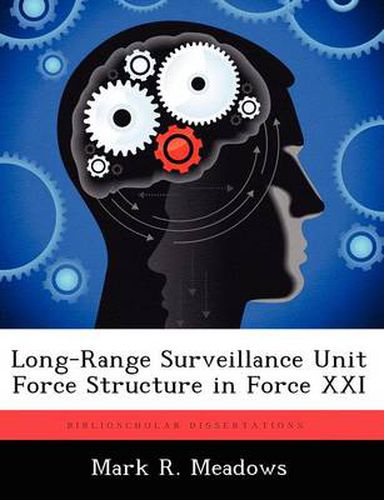Readings Newsletter
Become a Readings Member to make your shopping experience even easier.
Sign in or sign up for free!
You’re not far away from qualifying for FREE standard shipping within Australia
You’ve qualified for FREE standard shipping within Australia
The cart is loading…






This title is printed to order. This book may have been self-published. If so, we cannot guarantee the quality of the content. In the main most books will have gone through the editing process however some may not. We therefore suggest that you be aware of this before ordering this book. If in doubt check either the author or publisher’s details as we are unable to accept any returns unless they are faulty. Please contact us if you have any questions.
This study evaluates the capability of the current long-range surveillance (LRS) force to accomplish the reconnaissance requirements expressed in the emerging operational concepts of Joint Vision 2010. The study analyzes the role of LRS operations in the Army’s past and present doctrine. Additionally, the study analyzes what the future intelligence collection requirements are in accordance with Joint Vision 2010 and what role LRS units are capable of playing in the accomplishment of those requirements. Tactical command and control and training are the criteria used to establish a qualitative analysis by which to determine if the current LRS force structure is adequate to meet the needs of Joint Vision 2010 intelligence requirements. The study concludes with the observation that though LRS units are required in accordance with the Army’s most current doctrine, the current organization and force structure does not support the future reconnaissance requirements expressed in the emerging operational concepts of Joint Vision 2010. The study recommends a reformation of the current organization and force structure from separate detachments and companies under division or corps control to a LRS battalion assigned to the military intelligence brigade of a contingency corps. The battalion would be capable of providing modular, tailorable, force projection LRS detachments within their assigned division area of operation. Each LRS detachment will be designed, organized, trained, and equipped to accomplish the intelligence collection requirements of the future battlefield.
$9.00 standard shipping within Australia
FREE standard shipping within Australia for orders over $100.00
Express & International shipping calculated at checkout
This title is printed to order. This book may have been self-published. If so, we cannot guarantee the quality of the content. In the main most books will have gone through the editing process however some may not. We therefore suggest that you be aware of this before ordering this book. If in doubt check either the author or publisher’s details as we are unable to accept any returns unless they are faulty. Please contact us if you have any questions.
This study evaluates the capability of the current long-range surveillance (LRS) force to accomplish the reconnaissance requirements expressed in the emerging operational concepts of Joint Vision 2010. The study analyzes the role of LRS operations in the Army’s past and present doctrine. Additionally, the study analyzes what the future intelligence collection requirements are in accordance with Joint Vision 2010 and what role LRS units are capable of playing in the accomplishment of those requirements. Tactical command and control and training are the criteria used to establish a qualitative analysis by which to determine if the current LRS force structure is adequate to meet the needs of Joint Vision 2010 intelligence requirements. The study concludes with the observation that though LRS units are required in accordance with the Army’s most current doctrine, the current organization and force structure does not support the future reconnaissance requirements expressed in the emerging operational concepts of Joint Vision 2010. The study recommends a reformation of the current organization and force structure from separate detachments and companies under division or corps control to a LRS battalion assigned to the military intelligence brigade of a contingency corps. The battalion would be capable of providing modular, tailorable, force projection LRS detachments within their assigned division area of operation. Each LRS detachment will be designed, organized, trained, and equipped to accomplish the intelligence collection requirements of the future battlefield.